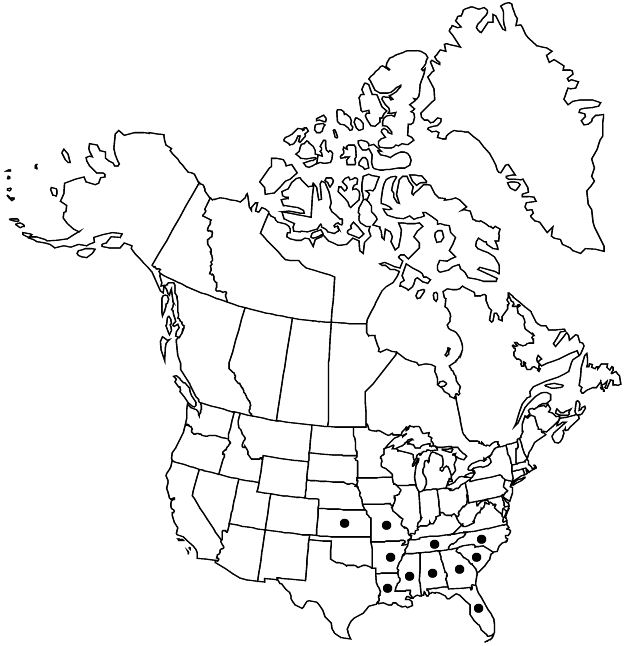Difference between revisions of "Crataegus berberifolia"
Fl. N. Amer. 1: 469. 1840.
FNA>Volume Importer |
RevisionBot (talk | contribs) m (Bot: Adding category Revised Since Print) |
||
| (4 intermediate revisions by 3 users not shown) | |||
| Line 24: | Line 24: | ||
-->{{Treatment/Body | -->{{Treatment/Body | ||
| − | |distribution= | + | |distribution=Ala.;Ark.;Fla.;Ga.;Kans.;La.;Miss.;Mo.;N.C.;S.C.;Tenn. |
|discussion=<p>Varieties 2 (2 in the flora).</p><!-- | |discussion=<p>Varieties 2 (2 in the flora).</p><!-- | ||
--><p><i>Crataegus berberifolia</i> is widespread from Texas to Missouri, Florida, and Virginia; it is particularly abundant in Louisiana.</p><!-- | --><p><i>Crataegus berberifolia</i> is widespread from Texas to Missouri, Florida, and Virginia; it is particularly abundant in Louisiana.</p><!-- | ||
| Line 56: | Line 56: | ||
|basionyms= | |basionyms= | ||
|family=Rosaceae | |family=Rosaceae | ||
| − | |distribution= | + | |distribution=Ala.;Ark.;Fla.;Ga.;Kans.;La.;Miss.;Mo.;N.C.;S.C.;Tenn. |
|reference=None | |reference=None | ||
|publication title=Fl. N. Amer. | |publication title=Fl. N. Amer. | ||
|publication year=1840 | |publication year=1840 | ||
|special status=Endemic | |special status=Endemic | ||
| − | |source xml=https:// | + | |source xml=https://bitbucket.org/aafc-mbb/fna-data-curation/src/2e0870ddd59836b60bcf96646a41e87ea5a5943a/coarse_grained_fna_xml/V9/V9_909.xml |
|subfamily=Rosaceae subfam. Amygdaloideae | |subfamily=Rosaceae subfam. Amygdaloideae | ||
|tribe=Rosaceae tribe Gillenieae | |tribe=Rosaceae tribe Gillenieae | ||
| Line 70: | Line 70: | ||
}}<!-- | }}<!-- | ||
| − | -->[[Category:Treatment]][[Category:Crataegus (sect. Coccineae) ser. Crus-galli]] | + | --> |
| + | |||
| + | [[Category:Treatment]] | ||
| + | [[Category:Crataegus (sect. Coccineae) ser. Crus-galli]] | ||
| + | [[Category:Revised Since Print]] | ||
Latest revision as of 18:07, 6 November 2020
Shrubs or trees, 60 dm. Stems: twigs: new growth orange-brown or green tinged with red, ± pubescent, 1-year old brown, older gray; thorns on twigs ± straight or recurved, 2-years old shiny black to chestnut brown, fine or stouter, (2–)3–4(–6.5) cm. Leaves: petiole 4–6 mm, length 13–18% blade, glabrescent, eglandular; blade narrowly obovate to oblanceolate, (2.5–)3(–4) cm, coriaceous, base narrowly cuneate, lobes 0, margins finely crenate or serrate except at base, or only beyond widest part, venation craspedodromous, veins 4–6 per side, apex subacute to obtuse, lustrous, abaxial surface ± densely pilose on veins, sometimes pubescent on surface, adaxial hairy young, glabrescent or becoming scabrous. Inflorescences 8–12-flowered; branches densely pubescent; bracteoles linear, margins glandular. Flowers 10–20 mm diam.; hypanthium villous or glabrous; sepals 3–5 mm, margins entire, abaxially glabrous; stamens 10 or 20, anthers cream or pink; styles 2 or 3. Pomes reddish to yellow, suborbicular, 8–10 mm diam., glabrous; sepals erose or patent; pyrenes 2 or 3.
Distribution

Ala., Ark., Fla., Ga., Kans., La., Miss., Mo., N.C., S.C., Tenn.
Discussion
Varieties 2 (2 in the flora).
Crataegus berberifolia is widespread from Texas to Missouri, Florida, and Virginia; it is particularly abundant in Louisiana.
Crataegus berberifolia is little differentiated from some forms of C. crus-galli, except in indumentum; it has relatively small and less variably shaped leaves. Its distribution is quite different. Intermediates with hairy leaves and glabrous inflorescences or nearly glabrous leaves and hairy inflorescences may represent hybrids with C. crus-galli (where they might be reached in the key). Such a situation is found in C. araioclada. Abrasion of the adaxial leaf pubescence may occur, rendering identification more difficult with fruiting material. Crataegus berberifolia has a plethora of yellow and orange-fruited forms, particularly from southern Louisiana. Crataegus fera and C. tersa are red-fruited, C. crocina yellow. The fruit color in the type is unknown; E. J. Palmer (in specimen annotation) called it yellow-orange. A form with exceptionally white-tomentose leaves near Copenhagen, Louisiana, is probably this species. Crataegus regalis var. paradoxa (Sargent) E. J. Palmer, from Missouri and adjacent Kansas and Arkansas, is probably a hybrid between the deeply serrated 'regalis' leaf form of C. crus-galli and a form of C. berberifolia. Two common forms of C. berberifolia occur, treated here as varieties: var. engelmannii with ten pink anthers and var. berberifolia with 20 cream anthers. Forms with 20 pink or ten cream anthers also occur sporadically.
Selected References
None.
Key
| 1 | Stamens 20, anthers usually cream; flowers 16–20 mm diam. | Crataegus berberifolia var. berberifolia |
| 1 | Stamens 10, anthers usually pink; flowers 10–15 mm diam. | Crataegus berberifolia var. engelmannii |